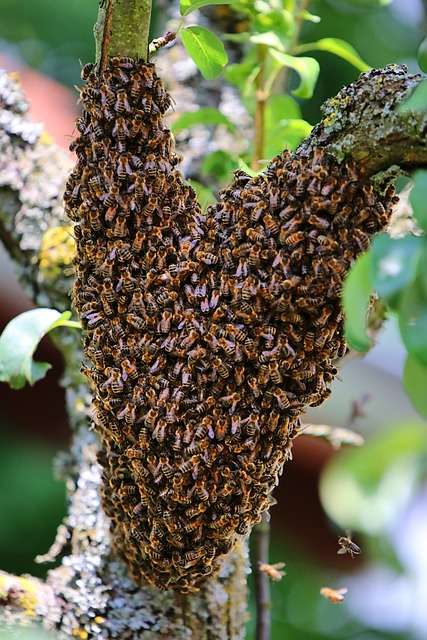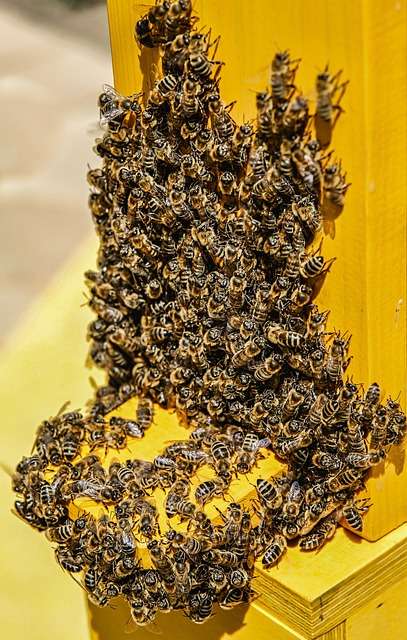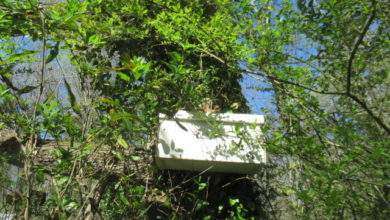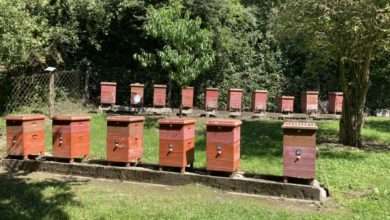Creating an Artificial Swarm

As a beekeeper, one of the most valuable techniques you can learn is creating an artificial swarm. This process involves dividing a healthy colony of bees into two separate hives.
In this article, we will explore the reasons why creating an artificial swarm is important, provide its definition in beekeeping, and outline the necessary steps to successfully accomplish the task.
Definition of an Artificial Swarm
An artificial swarm, as mentioned earlier, is the process of dividing a healthy colony of bees into two separate hives. This process is critical for a healthy bee colony because it encourages the growth of new colonies. Artificial swarms help avoid overcrowding, which can lead to a number of issues, including disease and swarming.
Importance of Creating an Artificial Swarm
Creating an artificial swarm is essential for bee colony management. It provides multiple benefits that can help your colony grow and produce more honey.
Here are some reasons why creating an artificial swarm is important:
- Reduces the risk of swarming: One of the main reasons for creating an artificial swarm is to reduce the risk of swarming. Swarming is a natural process where a portion of the bee colony leaves the hive in search of a new home. When a bee colony becomes overcrowded, it signals the bees that it is time to leave the hive. By implementing an artificial swarm, you can prevent this from happening and keep your colony healthy.
- Encourages brood production: Dividing a bee colony encourages the queen to lay more eggs, leading to increased brood production. This is beneficial for the colony as it allows for more bees to be raised, ensuring a healthier hive.
- Promotes honey production: When you divide the bee colony, you create two separate hives, each with its own access to resources. This can lead to increased honey production, providing more yield for the beekeeper.
Overview of Steps in Creating an Artificial Swarm
Here are the necessary steps to implement an artificial swarm:

1. Prepare equipment: Gather all the necessary equipment, including two hives, a queen excluder, and a bee brush.
2. Locate the queen: Find the queen and relocate her to the new hive. This step is necessary as the queen is the most crucial aspect of the colony, and it ensures that both hives have a chance to grow and flourish.
3. Divide the bees: Once you have relocated the queen, divide the bees between the two hives.
4. Install the queen excluder: After the bees have been separated, install a queen excluder to prevent the queen from flying off to the other hive. This step is critical as it ensures the queen remains in the designated hive.
5. Monitor the colonies: Finally, monitor both hives regularly to ensure they are growing and flourishing. Regular checks can help prevent issues such as swarm cells, which can lead to further complications if not addressed.
Assessing the Hive
When it comes to beekeeping, one of the most important things to do is to assess the hive. This means checking the strength and health of the current hive, as well as looking for signs of congestion or overcrowding. By doing so, you can determine the best time for creating an artificial swarm.
- Checking the Strength and Health of the Hive
Before you create an artificial swarm, you need to make sure that the hive is strong and healthy. This means making sure that the bees are active and productive, and that the queen bee is laying eggs properly. You should also check for signs of disease or pests, as these can weaken the hive and make it more susceptible to problems.
- Looking for Signs of Congestion or Overcrowding
Another important part of assessing the hive is looking for signs of congestion or overcrowding. This can happen when there are too many bees in a hive, which can lead to a lack of space for the bees to work and store honey. Some signs of congestion or overcrowding include bees clustering outside the hive, reduced honey production, and increased swarming activity.
Determining the Best Time for Creating an Artificial Swarm
Once you have assessed the hive and determined that it is strong and healthy, and that there are signs of congestion or overcrowding, you can start thinking about creating an artificial swarm. It’s important to choose the right time to do so, as this can maximize the chances of success.
One good time to create an artificial swarm is during the spring, when the bees are starting to become more active and there is plenty of food available. You can also create an artificial swarm towards the end of the honey flow season, as this can help prevent the hive from becoming too crowded.
Equipment Required
- Queen Excluder – This is a metal or plastic grid that fits over the top of the brood box. The queen excluder allows the worker bees to move from one box to another while limiting the queen’s movement. It is important to use a queen excluder during the artificial swarm process to ensure that the new colony formed does not have two queens.
- Brood Box – The brood box is the main area of the hive where the queen bee lays her eggs and the bees raise the brood. It is essential to use a brood box during the artificial swarm process because it will contain the majority of the bees and the queen.
- Supers – Supers are smaller boxes that fit on top of the brood box. They are designed to hold surplus honey and provide extra space for the bees. It is important to use supers during the artificial swarm process to ensure that the remaining bees have enough space to store honey and expand.
- Nucleus Box – A nucleus box is a smaller box that can hold up to five frames. It is used to house the portion of the colony that is being separated to form the new colony. The frames should contain brood, food, and bees to ensure the survival of the new colony.
- Bee Brush – A bee brush is used to gently remove bees from the frames and boxes during the artificial swarm process. It is essential to use a bee brush to avoid harming the bees and ensure a successful artificial swarm.
Selecting the Bees
Before creating an artificial swarm, the beekeeper must carefully select the bees that will form the new hive. There are several important factors to consider.
- Choosing the Queen
The queen is the heart of the colony, and selecting the right queen for the new hive is essential to ensure the success of the artificial swarm. The beekeeper must choose a queen that is healthy, vigorous, and has excellent egg-laying qualities. She must also be at the height of her laying season to ensure the new colony is off to a strong start.
- Selecting the Right Number of Bees
The beekeeper must also determine the correct number of bees to move to the new hive. The goal is to maintain a balance between too many and too few bees. It is generally recommended to move about two-thirds of the bees to the new hive, leaving behind enough bees to keep the existing hive healthy and productive.
- Ensuring the Bees are Healthy and Disease-free

A critical factor in selecting bees for the new hive is ensuring that they are healthy and disease-free. The beekeeper should inspect the bees for signs of infections and diseases, such as foulbrood or chalkbrood, and avoid moving bees with such symptoms to the new hive. The bees should also be free from mites, which can weaken the colony and spread diseases.
Here are the Steps Involved in Creating an Artificial Swarm
Step 1: Separating the frames with the queen and brood from the current hive
The first step in creating an artificial swarm is to locate the frames in the current hive that contain the queen and brood. These frames should be carefully separated from the rest of the frames in the hive. The reason for this is to ensure that the new hive has a strong foundation for the colony to develop. The queen and brood frames contain the future of the colony and are therefore crucial for the success of the new hive.
Step 2: Moving the selected bees to the new hive
After separating the frames with the queen and brood from the current hive, it’s time to move the selected bees to the new hive. The bees should be gently brushed off the frames and into a container that will transport them to the new hive. It’s essential to ensure that the bees are handled with care during this process to avoid injuring them or causing them to become agitated.
Step 3: Placing the frames in the new hive
Once the bees have been moved to the new hive, it’s time to place the frames with the queen and brood in the new hive. The frames should be arranged in the same order as they were in the original hive, to help the bees adapt quickly to their new home. It’s important to note that the new hive should have enough space for the bees to build new comb and store honey.
Step 4: Using the entrance reducer and queen excluder to keep the bees in the new hive
To keep the bees in the new hive, it’s important to use an entrance reducer and queen excluder. The entrance reducer is a small wooden board that fits into the entrance of the hive, which allows the bees to enter and exit the hive but prevents larger predators from entering. The queen excluder is a mesh screen that fits over the brood box and keeps the queen in the brood chamber while allowing worker bees to move freely between the brood chamber and the honey supers.
Post-Swarm Management
Congratulations! You have successfully managed a swarm and collected it into a new hive. However, your work doesn’t end there. In this section, we will discuss the important steps you need to take for post-swarm management.
- Checking the New Hive Regularly for Signs of Distress or Disease
After a swarm has been captured, the first thing you need to do is check the new hive regularly for any signs of distress or disease. The stress of the swarm and the transfer to the new hive can be taxing on the bees, and they may become more susceptible to diseases.
You should check the new hive every few days to make sure that the bees are settling in well and that there are no signs of disease or stress. Signs of distress or disease may include abnormal behavior, such as bees clustering outside the hive or not entering the hive at all, a lack of brood or honey stores, or a foul odor emanating from the hive.
If you notice any of these symptoms, you should take action immediately. You may need to consult a beekeeping expert or veterinarian to diagnose and treat the problem. In some cases, you may need to transfer the bees to a new hive to prevent the spread of disease.

- Feeding the New Hive if Necessary
Feeding your new hive is an important step in post-swarm management. After a swarm, the bees will need to build up their food stores and build comb to create a new home. If your hive has limited honey reserves, you may need to supplement their food supply with sugar syrup or pollen patties.
Sugar syrup is made by dissolving granulated sugar in water. The ratio of sugar to water should be 1:1 for spring feeding and 2:1 for fall feeding. Place the sugar syrup in a feeder inside the hive, making sure it is easily accessible to the bees.
Pollen patties are another source of nutrition for bees. They are made of pollen, sugar, and a binding agent such as corn syrup. Pollen patties are placed on top of the frames inside the hive and provide a supplemental protein source for the bees.
- Encouraging the Bees to Build Comb in the New Hive
After a swarm, the bees will need to build comb to store honey, pollen, and brood. You can encourage comb building by placing empty frames with wax foundation in the hive. The bees will start building comb on the foundation, which will provide them with more space to store their food and brood.
Make sure that the frames are spaced evenly in the hive, leaving enough space for the bees to move around and access the comb. If the frames are too close together or too far apart, the bees may not build the comb properly.
Conclusion
Creating an artificial swarm is an exciting and rewarding experience that allows beekeepers to control the population of the hive, manage costs, and ensure a successful season. Preparation and the right combination of pieces of equipment, hive structure, and a good understanding of the process are essential components of creating an artificial swarm. With a bit of practice and determination, any beekeeper can create an artificial swarm to ensure an exciting and successful season in beekeeping.




